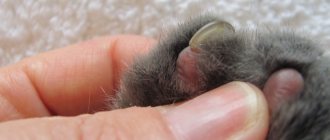Many are sure that cats naturally love to sit on their hands and do not need to be taught to do so. After all, they are so soft, fluffy, kind and gentle that sometimes it seems that they cannot live a minute without human affection. But this is not at all true - cats love freedom and come to a person only when they themselves want it. Some of them flatly refuse affection, and owners wonder how to accustom a cat to being handled?
How to tame a wild kitten
Future owners are worried: how to tame a kitten, what if the situation gets out of control and an unaffectionate cat will grow out of a cute creature. The baby quickly gets used to it and begins to understand:
- Where is the toilet.
- Where is the bowl of food?
- Who lives in the family, from whom you need to hide.
To tame a cat you will have to wait ten days (maximum). Usually this much time is spent on re-educating a street dweller.
It’s worth learning from the very beginning: a kitten’s squeak means “I feel bad,” while purring is a sign of goodwill and contentment.
There is no need to push a squeaking lump into a bathtub of water or allow children to cause pain. The kitten should feel safe and loved. It’s easy to accustom a kitten to handling and rules of behavior (both in the house and at an exhibition): affection, play and treats will do.
Once the baby is in the house, you need to give him time to calm down. You can leave him in an unlocked cage or put him in a low cat basket. Don't forget to place a bowl of water nearby.
In a calm environment, the kitten will soon crawl out of its shelter and go to inspect the territory of the house. Don't pick him up just yet. It is enough to gently stroke him and say a few words in a calm tone. Then transfer to a bowl and praise. In this case, the kitten in your hands will not perceive the action as danger.
Within 24 hours, the cat will begin to trust its owner and may jump onto its lap. The kitten will learn to sit quietly in your arms if you support it by its back. The warmth of the hand is soothing, and any possible fear of heights disappears.
How to make a street cat a domestic cat?
If you met a cat on the street that you couldn’t pass by, then you need to understand that a free-roaming pet still has to be made into a pet. The success of this process depends on both you and the four-legged beauty, because everyone has to change their lives.
Let us immediately stipulate that you need to carefully observe the animal, its reaction, in order to understand how it feels, what its fate was. Cats become homeless in three ways:
- born on the street;
- lost;
- were thrown out by their previous owners.
A lot will depend on this:
- young kittens retrain quite quickly;
- Cats (who used to be domestic cats, but have recently become lost or abandoned) will easily remember old habits and follow the rules of the new home;
- Adult cats (who spent a long period on the street and managed to go wild) have a hard time forgetting street habits, have a harder time adapting to the litter box, and do not immediately understand the increased demands on their behavior.
When choosing a cat, be prepared to be patient and loving, and then the animal will respond to you with gratitude.
Let's figure out where to start to make an outdoor cat feel at home in an apartment.
1) Feed the animal. Be sure that he or she is definitely hungry, and food will endear your pet to you in the best possible way.
2) Swimming.
You need to wash the cat as soon as possible, ideally before allowing her to explore the new territory (that is, the scheme is as follows: fed at the doorstep and immediately into the bath). This is a necessary measure, since on the street the animal probably picked up fleas or ticks, and on its fur it carries a bunch of pathogenic bacteria that are dangerous to humans.
We warn inexperienced cat owners that they should only wash their pets with a special shampoo. The products are not suitable for humans, they can cause severe allergies and irritation, they are difficult to wash off from the fur, and when licked, they can poison the animal. It is best to purchase a special anti-flea and tick shampoo at a pet store or veterinary pharmacy, suitable for the age of the pet (for kittens or adult cats) - this way you will clean up and begin the fight against parasites.
3) Prevent worms and helminths.
As soon as possible, you need to help the animal get rid of parasites that bother even small kittens. In the future, prevention even for domestic cats will need to be done once every six months.
If you do not know which drug to choose, it is better to consult your veterinarian.
4) Visit a veterinarian.
A visit to the veterinarian should be scheduled as early as possible, in the first 2 to 3 days. In fact, that's where we'd recommend starting. Namely, buy food and feed a street animal right on the street. Take the cat and take him straight to a good clinic. The doctor will conduct a full examination of the animal, make a diagnosis and recommend treatment methods. In the veterinary pharmacy at the clinic, you can immediately buy everything you need; specialists will tell you what is best to choose for your rescued animal.
Large clinics offer grooming or animal sanitation services. Specialists will take your place in the first bath, clean your ears of ticks, treat your fur for fleas, and give you the necessary medications. This way you will eliminate the chance of bringing infectious elements into your apartment, and an already clean animal will enter a clean house.
In addition to these problems with parasites, your four-legged friend may suffer from lichen, fungus, or other “street” ailments. By neglecting the help of specialists, you risk both the life of the cat and the health of your family members (some diseases are contagious to people).
If you are not ready to give your little creature your love and care and carry out comprehensive treatment, it is better not to interfere and do not take your pet into your home.
This is the minimum set of operations that need to be done in the first couple of days. Next, you have to tame the animal, introducing it to the rules of your home.
It is the age and experience of the pet that will largely determine how quickly you can achieve domestication.
As we have already said, kittens (up to 7-8 weeks old) and adult cats that have recently been brought outdoors learn quickly. They are not afraid of people, make contact easily, and are ready to make friends with bipeds.
If your pet shows signs of aggression or fear, do not disturb him, give him time to get used to it and trust you, otherwise you will simply feed his fear and desire to defend himself even more. Be patient, feed the aggressor, and don’t scold him too much for the puddles on the floor; for him, a person is a threat, not even a careful visit to the litter box.
The first thing that a cat will quickly get used to is its feeding place. Place the bowl away from the tray, keep it clean and do not move it around the house at first. That's all you need for successful feeding.
The second important question is how to train an outdoor cat to use a litter box. Place the tray in a place that is easily accessible to the cat. First you need to select a filler that closely resembles your usual environment. Buy small packages of different types - wood or grain. Stock up on products from your veterinary pharmacy to help train you to use the litter box - these are sprays with different odors that are unpleasant for your cat. Using such means, you need to treat the place where the pet peed so that it does not repeat the mistake in the future.
Experienced cat breeders use a little trick:
- They soak a piece of newspaper in the prankster's puddle;
- Place the smelling newspaper in the tray (you can even do it without filler, so as not to interrupt the smell);
- They replace newspapers with fresh ones if mistakes are repeated, and the places of mistakes are carefully washed away;
- Gradually remove the “fragrant” newspapers from the tray and add more filler.
This method is based on the desire of any cat to relieve itself in the same place, and pets determine this place by smell. If the smell of cat urine in the apartment is only in one place and is pronounced, then the animal will quickly get used to this order.
It is important not to scold or punish for puddles, especially at the beginning of the journey. Just transplant the smoker into the tray immediately after the mistake.
The remaining subtleties of training are based on affection and care.
Accustom your cat to a scratching post, prohibit climbing on tables and stealing food, minimize aggression and get a fluffy little ball that can be caressed and stroked at any time. Nothing is impossible for a caring owner. Love your pets, show them your affection in your voice, look, stroke and play with them more often and the cat will be grateful. Share with friends:
How to accustom a cat to hands and affection
If you want cat affection, become patient and affectionate yourself. An outdoor cat will begin to trust a person when it gets used to his smell and voice. He will associate his appearance with a pleasant event (food, affection).
A wild cat is tamed in the same way as a kitten. First, treats are brought regularly. Then they hold out their palm with a piece of the most delicious thing (the delicacy lies in the center of the palm, not on the fingers!), and allow it to be sniffed. When the cat begins to approach, perhaps rubs its head on its leg, you can pet it in response, speaking calmly and affectionately.
A common mistake: in order to tame a cat at home, he is immediately locked in a room - the animal will try to escape as soon as it is freed.
You can call the cat with you, after a few meters, stop, praise, and give a treat again. The main thing is that if you come, give her the opportunity to leave. Without feeling afraid, the pet will return.
Common Mistakes
It's not easy to find a balance, but if you have one cat acting jealous, chances are you're neglecting her in favor of the other. While you should be working to help the new cat acclimate, be sure to take some time to spend with your current feline housemate.
This could be offering a special treat or brushing their fur while praising them.
But you will definitely need these articles if you want to take home an adult street cat:
How to remove cat urine, vomit, feces, hair?
How to Remove Cat Urine Smell from Furniture, Carpets, Belongings and Clothes
Cats fight each other at home - what to do
How to bathe a cat or kitten
Why is my cat sad?
And a lot more about cats...
Why is the cat not affectionate?
If a cat scratches and bites as an adult, the owners themselves are to blame. While still playing with her, they allowed her to “claw” in excitement. At first it's funny, then the adult:
- bites legs;
- does not allow himself to be combed;
- spoils things, marks territory.
The simplest veterinary examination and medical procedures (injections, enemas) turn into a nightmare for the owner.
The independence and aggressiveness of a mustachioed cohabitant should not be shown towards family members. If the owners are afraid, the pet will become impudent. It is recommended to hold the cat in your arms more often and show affection. After taming, release it for further exploration of the area, praise and treat it with something tasty for good behavior.
Gradually the cat will understand: nothing bad is happening. If you do this regularly, at the same time talk affectionately, give a piece of “yummy” - after a while you can add short-term combing, examining the ears and other manipulations.
An irrepressible desire to “cuddle” can also be the reason why a cat becomes less affectionate. Small children will happily play with the kitty and pull its ear or tail.
Adults sometimes don’t lag behind (especially if the cat is not their property): they shamelessly shove pieces from the table, try to stroke them and pick them up against their will. It's not the cat that needs to be blamed, but the owner:
- If the cat is not the highlight of the program, it is better to isolate it in another room. Or warn the guest about correct behavior.
- For children, it is better to find other fun, otherwise the simplest scratch on the hand of an uncontrollable child will ruin the evening.
- When neither the person nor the cat is particularly anxious, let them interact as they wish.
Advice. It is advisable to wash your hands not only after interacting with an animal, but also before. Precautionary measures apply to small unvaccinated kittens.
The selection of some breeds followed the path of consolidating external characteristics. Such cats are more attached to the territory than to the owner. For example, bobtails and Norwegian forest cats do not recognize excessive affection.
It is better to choose a Burmese, Siamese, Sphynx or Rex or an ordinary yard cat - a “mongrel”. “Human-dependent” cats can hardly tolerate loneliness, they are easy to tame and they love the affection of their owner.
What do experts recommend?
You need to gradually accustom your cat to human contact. It is very important that your pet feels comfortable and safe. To prevent the kitten from being scared of you, it is important to speak to it in a monotonous and soothing tone. Take a closer look at the following tips if you are faced with the need to accustom your cat to affection:
- Start with normal touching. Approach your cat several times a day and scratch it. At first she may get scared or run away. Usually, untrained animals simply show dissatisfaction. Short strokes with the spoken phrase “good boy” and other pleasant words can smooth out such a situation;
- Use a treat. Every pet has food that it is very partial to. At first, you can sit on a chair, taking a treat with you. Call your pet over to give him some food. Wait until he jumps into your arms. This method is good when the cat is already accustomed to your stroking;
- When a kitten has a favorite toy, you can try to interest him in such entertainment. You can use a soft ball, bows, and items purchased from a pet store. It is important that the item used does not damage the animal’s teeth and oral cavity;
- Teach your pet to eat from your hands. Right away you can simply give small pieces of food, and then feed and pet the animal at the same time.
The most popular methods for teaching a cat to be handled are listed above. Of course, it is necessary to take into account the individuality and uniqueness of each pet. Representatives of the cat family love to be taken care of. To reach this level of relationship with your pet, sometimes you need to try and be patient. But it also happens that a cat shows a friendly attitude towards some people, but is wary of others. In this case, we recommend that you resort to the same methods and give the kitten the opportunity to gradually get used to your loved ones. It is much more difficult to train an adult animal, since it has already formed certain patterns of behavior. In order to change your pet's habits, you need to develop a special approach to it.
Is it possible to tame an adult cat to a new owner?
A cat tolerates a change of owner more easily than a dog. The exception is socially oriented breeds, for example, Oriental Siamese. They will gradually become affectionate with their new owners, but the first one is the only one for life.
The best way to train, even for a sexually mature individual, is not food, but play. First, an adult cat must get used to the territory. It is better to leave your pet to explore its new home on its own, and after a while offer some food from your hands. Just like a treat. At the same time, do not forget to talk measuredly, but not to stroke.
As soon as the cat gets used to it a little, you can:
- lightly scratch a chair or furniture - so that the cat reacts to the sound near the owner;
- roll a ball or ball of wool near you, inviting you to play;
- “drive” a candy wrapper.
The cat quickly joins the game. After a while, you should again give a piece of food from your hand and praise it.
Think about your cat's stress
Finding yourself in a new situation with new people and relationships is stressful. In some cases, a cat may become the target of aggression from local cats, making it difficult for the newcomer to show affection to its human owners. Stress can also affect your cat's appetite, mood, and sleep.
If you can identify and eliminate stress or change the behavior of another, more aggressive cat, you can encourage her to relax and feel at home.
Stress in a cat - how to cure it
Cat's stress after moving
Remember that a cat is a wild animal
The history of breeding domestic dogs goes back 100,000 years; they were domesticated long ago, as they were actively involved in hunting and home guarding. The benefits of breeding dogs have always been obvious to humans. With cats the situation is different. Undoubtedly, in history there are isolated cases of owning cats; just remember the great Cleopatra and Ancient Egypt. Cats began interacting with humans about 5,000 years ago, but mass domestication of furry cats lasts only 200 years.
Therefore, the connection with these animals is not so strong. You should not expect boundless trust and affection from a cat; genetic memory still does not allow him to completely relax next to a person. “Cats are not dogs,” says renowned cat psychologist Jackson Galaxy, “I know it sounds strange, but we always look at cats through the prism of a dog’s perception. We must treat cats with the same dignity as humans. This means a much slower introduction process and respects that the cat is programmed to be a self-sufficient, free-spirited hunter."
“The cat begins to pick up signals as soon as you enter the house. She can smell other animals on you, even the scent of that dog you just walked past. So if you had contact with another animal on the way home, where the cat is waiting for you, try to get rid of foreign odors, says renowned feline behaviorist Michel Nagelschneider.
Once you get inside the house, avoid blocking any exits the animal perceives. Do not close doors or block passages; such actions signal danger in the eyes of the cat.
Games and communication
Cats are hunters by nature. And the point here is not in saturation, but in the process of catching and proving to a person its benefits. In confirmation of the latter, they often bring caught prey to their owners without touching it to eat it.
Therefore, in order to win over a cat, you need to create conditions for it to simulate hunting. For example, buy toys or make a simple bow on a string yourself. It is important to remember safety, because at such moments the pet is not aware of what and with what force he is biting, and can damage his teeth on a hard object or cut himself on a thin thread.
Cats need companionship. Moreover, the tone and mood with which the words are spoken matters. After all, cats perceive them, and not the meaning of spoken words.
If you treat your pet with respect and love, then he will never scratch, bite, go to the toilet in the wrong places, or harm in other ways. This behavior only occurs in response. Therefore, you need to look for the reasons in the owner, because he has full responsibility for the cat.
Say "hello" like a cat
You've probably seen how cats greet each other. No, they don’t sniff their partners’ bottoms. A cat's friendly attitude can be recognized when it touches the other cat's nose with its nose. Why don't you try it too? Just don’t need to get on all fours and nuzzle your fluffy one now. It will be enough to raise your finger. Simply reach in and extend your index finger. The kitty will certainly come closer to you to smell it. As soon as she wipes her muzzle on her finger, you can consider the greeting complete.
Such a ritual will not only bring you closer to your cat, but will also add a few points of respect from her.
When to start raising a kitten, how and what to teach it
The optimal age for parenting occurs immediately after the adaptation period. Be attentive to the kitten's habits if it is more than 3 months old. It is extremely important to correct your pet’s behavior gently, in a playful or rewarding way.
. Don’t even think about hitting a kitten for training purposes; this will make your pet more nervous and timid, but not at all obedient. Avoid stressful situations
up to 6 months of age of the kitten:
- Frequent arrivals of guests, noisy parties or celebrations. Yes, it is a sacrifice, but it is made to strengthen your pet's psyche.
- Walking on a leash is of no use to the baby; he needs to fully explore the home, every cabinet and every shelf. In addition, a pet that has not received it should not come into contact with street animals, this is fraught with viral diseases, sometimes fatal.
- Punishment - at this age, the kitten is very pliable and its behavior must be corrected exclusively with positive motivation.
Cats are very receptive to training until they are one year old.
, this period is quite enough to master basic skills. The first priority is this. On the very first day, keep an eye on the baby, as soon as he starts to “fumble” in search of the toilet, transfer him to. If you don't have time, quickly blot up the puddle with a paper napkin and place it in the tray. Even 2-month-old kittens have a keen sense of smell and rely on it when searching for a litter box.
Important!
If you have multiple cats in your home, get extra litter boxes! Firstly, each pet should have its own toilet, and secondly, do not forget that some cats go to different litter boxes - big and small.
Try to take the kitten to the toilet 15–20 minutes after feeding
and stay with the baby until he relieves himself. It is worth refraining from frequent cleaning of the tray, since fresh litter does not have a characteristic odor. Keep the trophy napkin (or replace it with a piece of cloth), praise your ward every time until the habit of going to the litter box is established.
Pet your cat only where she allows it.
For cats, where you pet her is a very important factor. If you constantly want to stroke her belly, but she doesn’t give it, it definitely won’t add love to you. If your pet wants this, he will lie down on his stomach.
Start with a light massage of the cheeks and neck. If the cat likes it, it will begin to purr, squint and lightly move its paws. If you pet in an inappropriate place, the cat will begin to wag its tail and become a little tense.
Remember: each animal's g-points are different. But if you find them in your cat, long and sincere love is guaranteed.
Just like getting ready for a date: how beavers wash themselves in the river (video)
For Svetlana, he left his first wife and daughter: Valdis Pelsh’s second family (photo)
Cake “Fruit Paradise” with mascarpone cream: a recipe for a dessert with vanilla flavor
Taming methods
Time and hunger are the most faithful helpers on the path to taming a wild cat. First, the animal must be isolated by placing it in a cage or carrier. It is better to place the cage in a separate room or cover it with a rag, creating the illusion of loneliness for the animal and depriving it of all kinds of entertainment, even the opportunity to observe the situation. There should be no food or toys in the cage, only a bowl of water and a tray.
After your pet has been sitting in the cage for several hours, you need to go up and hand him a piece of tasty food in your palm. This could be some soft food or a small piece of chicken. If the kitten hisses, tries to hit with its paw, backs away, immediately remove your hand and walk away. Try again after a couple of hours. If the result is the same, leave the animal for a few more hours. Sooner or later, hunger will force the cat to come up and take the treat from your hand. Once this has happened, you can consider that half the job is done.
Now the main thing is patience and systematicity. It is necessary to approach the kitten more and more often with small pieces of food, each time giving it food from your hands. If he refuses, immediately leave, taking the treat with him. This way your pet will quickly get used to eating from your hands.
At the same time, you need to start raising your pet. With the cage door slightly open, place your hand close to him (without touching him). Ignore the hissing, but if he tries to attack, then lightly fight back. When the kitten stops objecting and calmly accepts the owner’s hand in close proximity to itself, reward it with a treat.
Frightening look
When the baby is already eating from his hands, it's time for the next step. Holding the food in your palm, you should try to pet the kitten before giving it the food. To his objections, the owner’s reaction is the same - to leave and take away the delicacy. After several approaches, the animal will understand that stroking is pleasant, safe and will accept it with pleasure.











